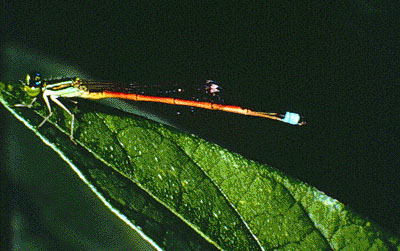 |
Order
- ODONATA
(Greek, odous = tooth)
Common Names: dragonflies, damselflies
Distribution: Cosmopolitan
Suborders: Anisozygoptera, Zygoptera,
Anisoptera
Description
Odonata is a very ancient order of insects with fossils dating from the
Upper Carboniferous. Some species from this time period had 70 cm
wingspans. Damselflies and dragonflies are very similar in appearance but
differ as follows: at rest, the wings of dragonflies are spread out
perpendicular to the body (resembling aircraft wings), damselflies bring
their wings together loosely over the back of the abdomen; dragonflies
tend to be more strongly built insects, damselflies tend to be rather
delicately built; dragonfly nymphs are heavily built mud-dwellers, while
damselfly nymphs frequent tangled vegetation at the sides of the stream or
pond and have two flattened abdominal appendages which are absent in
dragonfly nymphs. All adults have short antennae composed of straight
segments (filiform) and prominent compound eyes; simple eyes (ocelli) are
usually present. The mandibles are well developed and all adult species
are predatory on other aerial insects. The two pairs of wings are large,
membranous and equal in size with prominent venation.
Naiad
There is no metamorphic cycle of egg, larva, pupa and adult. Instead the
juvenile emerges from the egg as a wingless form of the adult (nymph). However,
the overall body shape may be much shorter and robust. A feature of dragonfly
nymphs is the extendable lower lip (labium) or mask which is equipped with
pincers. The labium is thrust forward very rapidly to secure prey. As they
develop, dragonfly nymphs become capable of securing quite large prey including
tadpoles and small fish. During development through a number of moults, wings
begin to appear, but these are non-functional. At maturity, the nymphs move to
the surface and emerge onto reeds or similar surfaces. The adult emerges by
breaking through the nymph’s final exoskeleton. The adult legs are used to
capture aerial insects by forming a "basket" in which the prey is
first secured then transferred to the insect’s mouth.
Members
Dragonflies, damselflies.
Food
When in the aquatic phase, any suitably sized animal is captured for food.
This may include insects, tadpoles, fish, wrigglers, etc. Once the adult form is
reached, most food is captured in flight and consists of other winged insects,
particularly those associated with ponds or streams.
Importance
Dragonflies and damselflies form an extremely important group of predacious
insects in stream and pond ecosystems. They are responsible for population
control on a number of associated insect species. The adults are quite long
lived and consume large quantities of insects over many weeks.
|